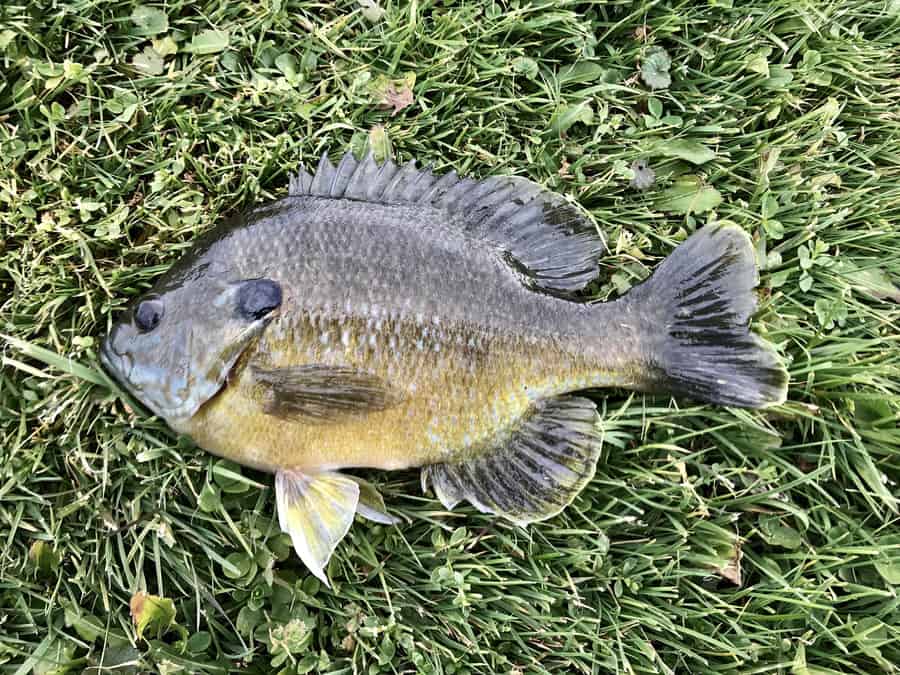Best Time to Catch Bluegill (Complete Guide)
Leave a comment after this article and let’s talk more about bluegill fishing. I’d love to read your feedback.
The best time of day to catch bluegill is typically early morning or late evening, as these fish are most active and feed near the surface during these cooler parts of the day. During midday, especially in warmer months, bluegill tend to move to deeper, cooler water and become less active, making them harder to catch.
In most situations, bluegills feed more aggressively in the late evening as the warm begins to cool. Shadows in the water caused by vegetation and docks cast larger affording bluegills the ability to better see surface food. Check out this helpful guide on how water temperatures affect bluegill fishing.

This is also the time when aquatic and terrestrial insects are more active resulting in greater feeding opportunities for hungry bluegills. As sunset nears, bluegills start to slow down, and feeding tapers off.
This pattern is pretty reliable from everything I’ve seen and read. The major exception to this rule is on cold, overcast days and also in hours before and after major storm systems.
Table of Contents
Best Time to Catch Bluegill
Table: Best Times to Catch Bluegill
| Time of Day | Activity Level | Best Strategy | Notes |
|---|---|---|---|
| Early Morning | High | Surface or shallow water fishing near structures | Ideal for topwater lures and live bait |
| Midday | Low | Deep water fishing, slower retrieval | Less likely to bite, patience required |
| Late Evening | High | Surface or shallow water fishing, active feeding near shore | Excellent for fly fishing and light lures |
| Night | Variable | Use light or glow-in-the-dark baits, focus on known bluegill spots | Success depends on moon phase and water clarity |
What’s the best time of day to ice fish for bluegills?
The best time for ice fishing for bluegill is typically during the early morning and late afternoon hours, as bluegill are most active and feed more aggressively during these periods. Midday can also be productive, especially on overcast days, but generally, the hours around dawn and dusk offer the highest chances of success.
Ice fishing is one of my very favorite activities and my favorite way to fish. For those lucky enough to live in areas that see “hard water” during the winter, there are certain times of day that produce good bites.
If I’m ice fishing for bluegills, I shoot for mid-to-late afternoon. This mirrors summer fishing in a lot of ways but when lakes are covered in ice, you can see hotter bites in the early-to-mid afternoon window too.
Click here for a complete breakdown of impacts of colder weather conditions on fishing for bluegill. You may also be interested in an article we wrote on the morning fishing for bluegill.
How to Fish Bluegills at Different Times of Day
Early Morning
Location: Near shorelines & under docks
Bluegill Activity Level: Docile
Baits: Grasshoppers or small minnows. Definitely grasshoppers
Notes: Fish slow. Let the bait do all the fishing for you. Don’t even consider using lures now.
Late Morning
Location: In water 3-8 feet deep; huddled near shelter
Bluegill Activity Level: Perking up a bit
Baits: Live bait (grasshoppers, minnows, worms) & maybe a small lure like a jig or spinner
Notes: Monitor fish activity level. If they look docile, they are. If they are swimming around and feeding, get more aggressive.
Midday
Location: Tightly stacked under overt cover like docks & logs; in deeper water near cover
Bluegill Activity Level: Conserving Energy but Antsy
Baits: Live bait (grasshoppers, crickets, minnows, and worms), Powerbait may work too
Notes: Finding fish now is easy, convincing them to bite is your job. Cast your bait as close to shaded water as possible.
Early Afternoon
Location: Under or near cover: shallow or deep
Bluegill Activity Level: Starting to venture out of shaded water; feeding picking up
Baits: Live bait (worms and minnows); you can experiment with lures now
Notes: You’ll find as the sun gets less intense, bluegills will start to leave cover and feed more. Don’t fish too aggressively but I think you can try lures now.
Late Afternoon
Location: Near Cover or roaming near the surface
Bluegill Activity Level: Very active
Baits: Any bluegill baits work now (live bait, lures, dead bait)
Note: Have fun and enjoy the cooling temps
Night
Location: down deep or near cover
Bluegill Activity Level: Docile
Baits: Live bait only (minnows or worms)
Note: Fish can still be caught at night but be patient and fish very slowly
Related Questions
When are bluegill most active?
Bluegill are most active during the daylight hours, especially in the early morning and late afternoon. They tend to be more active during the warmer months, preferring water temperatures between 70-85 degrees Fahrenheit. When the water is warmer, bluegill are more likely to feed, making it an ideal time for fishing.
How does temperature affect bluegill activity?
Bluegills react very noticeably to water temperature changes. They don’t like warm water as they seek shade during the midday sun and their feeding activity drops off. They also are very docile at night and early morning in cool water.
They seem to prefer water in the low-to-mid 70’s the best. This is one of the best at-depth digital thermometers available and can measure down to 300 feet of depth. It is a bit pricey but a great investment for all species of fish.
When do bluegill stop biting?
Bluegill typically start biting in late spring and early summer, when water temperatures reach around 70 degrees Fahrenheit. They become more active during this time, making it easier to catch them. However, the exact timing can vary depending on the location and weather conditions.
